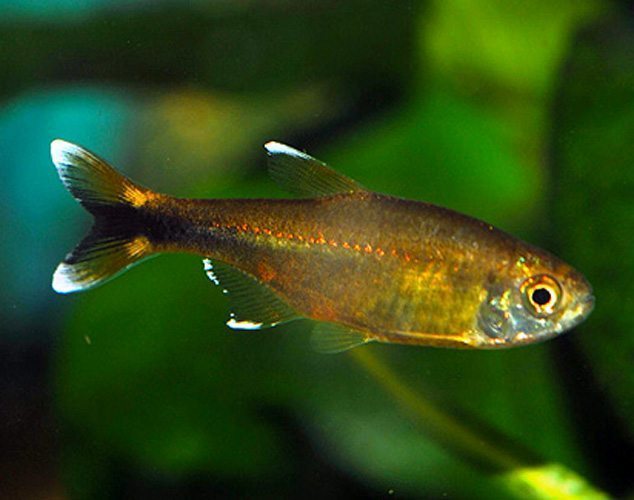Popular Name: Tetra Silver Tip
Scientific Name: Hasemania nana, Lütken, 1875
Family: Characidae
Origin: South America / São Francisco River Basin
Sociability: School
pH: 6.0 to 7.2
Temperature: 22 to 28°C
Water hardness: soft to medium
Life expectancy: About 5 years
Maintenance: Easy
Adult Size: Approximately 5 cm
Food: Omnivorous, accepts everything, to encourage reproduction and keep your fish healthy and with beautiful colors, it is recommended to offer live food at least once a week.
Recommended Ration: MegaFood Tropical Basic accompanied by MegaFood Spirulina
Sexual dimorphism: The male is smaller, more colorful and the belly is straight. The female has a less intense coloration, the belly is plump and is larger than the male. Important: these characteristics appear in fish at the end of the juvenile stage and in adults, the sexual difference between offspring is more difficult to be observed.
Behavior: They are schooling and peaceful fish.
Reproduction: Oviparous, are considered free spreaders, as the female releases her eggs into the water and the male swims around fertilizing them. Eggs hatch within a few hours when kept at a higher temperature and after two or three days of hatching the fingerlings have already consumed the contents of the yolk sac and begin to swim.
There is no parental care among fish of this species, from the moment the pups are free-swimming, specific rations can be offered for oviparous fingerlings and live food such as infusoria, microworms, brine shrimp, as the pups grow food larger living can be offered.
Newborn eggs and fingerlings are very sensitive to light, so an aquarium with several floating plants to attenuate the light is necessary.
It is recommended to use an internal foam filter or put perlon in the water inlet of the external filter to avoid sucking the puppies, when in aquariums suitable for reproduction.
Minimum aquarium size: 50 liters.
Other information: As they are shoal, these tetrinhas should not be kept in groups of less than 5 individuals, the larger the shoal, the more natural their behavior. The disputes over territory or females are magnificent to watch, the males (usually the biggest among them) face off and display their fins and colors in as much splendor as possible. They are beautiful fish for planted and themed aquariums!
The genus Hasemania is one of the few among the Characidae family in which the species does not have an adipose fin.
These fish show their coloration vividly only when kept in an ideal environment, fish in a stressful situation (store batteries, right after transport, etc.) can show a very pale color, which is easily reversed when transferred to a location with parameters and species-appropriate needs.
It is extremely important to monitor the water parameters, for which periodic pH, GH, KH, Ammonia, Nitrite and Nitrate tests are recommended. There are products that constantly test certain parameters, without the aquarist needing to do them all the time, and that allow 24-hour monitoring, they are Seachem Ammonia Alert and Seachem pH Alert – both available in our “Medicines and Tests” area. All other chemical tests can also be found in the same above-mentioned area of the website.
Equally important is the constant maintenance of the water temperature to avoid sudden drops that can lead to the weakening of the animal’s immune system and the emergence of diseases. This maintenance is achieved with the aid of heaters and/or thermostats – the latter being the most recommended, as they have a mechanism that controls the temperature, thus avoiding excessive heating of the aquarium water – and it is monitored using thermometers that can be either internal and external. Accessing our area entitled “Temperature” you will find several options for thermometers, heaters and thermostats.
Fish that can be placed with tetras: Tetras are shoals, you must place 3 units (minimum) of the same type of each tetra. In addition to other male and female tetras of any other variants, you can place them together with all small and medium-sized acidic fish. Do not place them with adult mites or river fish (they can eat them if they fit in your mouth). You can adapt them to neutral pH and place with all fish of this pH. We don’t recommend putting it in alkaline pH, as it decreases its life expectancy from hours (depends on the acclimatization) to years and will silently mistreat them, forcing its nature (we don’t agree).
